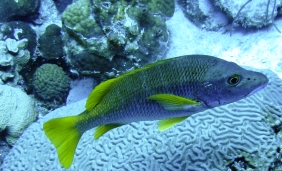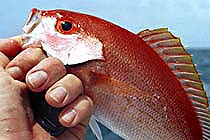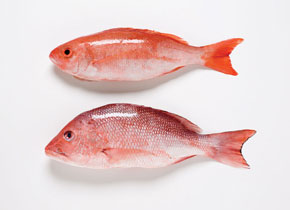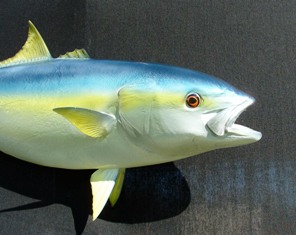Discover Florida Nature
It's time to explore the natural Florida


|
|
|
|
|
 Schoolmaster
(Lutjanus apodus) The Schoolmaster fish is a
member of the snapper family, and belongs to the grey snapper family
group. It's closest relative is the dog snapper. Schoolmaster snapper
has 39 to 44 scales in the lateral line and is an orange yellow with
reddish tinges about the head .Along the sides of the schoolmaster are
about 8 pronounced vertical darkish bands separated by narrower silvery
bands. The fins are also yellow or tinged with orange. Schoolmasters
grow to two feet and weigh 15 to 20 pounds. An average schoolmaster will
weigh 7 to 8 pounds. The schoolmaster can be found in the western
tropical Atlantic from Brazil to the West Indies and Florida, with the
young scattered widely northward along the coast. Schoolmaster snapper
have been recorded from Cape Cod in early September. The schoolmaster is
found in the shore area along with the grey and dog snapper, but seems
to prefer more open water and sandy bottoms near coral reefs. It also is
found in fresh water sometimes long distances from brackish waters. A
slow grower, the schoolmaster feeds principally on crabs, shrimp,
gastropods, and small fishes. This snapper can be found schooling during
the daytime but breaking up at night during feeding times. It is a
favorite game fish because it bites readily and gives a vigorous fight. Schoolmaster
(Lutjanus apodus) The Schoolmaster fish is a
member of the snapper family, and belongs to the grey snapper family
group. It's closest relative is the dog snapper. Schoolmaster snapper
has 39 to 44 scales in the lateral line and is an orange yellow with
reddish tinges about the head .Along the sides of the schoolmaster are
about 8 pronounced vertical darkish bands separated by narrower silvery
bands. The fins are also yellow or tinged with orange. Schoolmasters
grow to two feet and weigh 15 to 20 pounds. An average schoolmaster will
weigh 7 to 8 pounds. The schoolmaster can be found in the western
tropical Atlantic from Brazil to the West Indies and Florida, with the
young scattered widely northward along the coast. Schoolmaster snapper
have been recorded from Cape Cod in early September. The schoolmaster is
found in the shore area along with the grey and dog snapper, but seems
to prefer more open water and sandy bottoms near coral reefs. It also is
found in fresh water sometimes long distances from brackish waters. A
slow grower, the schoolmaster feeds principally on crabs, shrimp,
gastropods, and small fishes. This snapper can be found schooling during
the daytime but breaking up at night during feeding times. It is a
favorite game fish because it bites readily and gives a vigorous fight. Silk
Snapper
(Lutjanus vivanus) The yellow iris identifies the
silk snapper from its close relatives, the red snapper and the blackfin
snapper, both of which possess a red iris. The blackfin also has a vey
distinctive black spot at the base of the pectoral fin. Another
red-colored sapper, the vermilion snapper, is distinguished by its more
streamlined body and deeply forked tail. The body of the silk snapper is
red overall, darker above and lighter below with fine wavy longitudinal
yellow lines. The caudal fin has a dusky margin. The silk snapper
commonly occurs in the western Atlantic from northern South America to
North Carolina. It is found in the Gulf of Mexico and Caribbean as well
as around Bermuda. Off Bermuda, the species is common at depths of
400-500 feet during the day, and shallower waters at night. In the
Bahamas, it is caught by the Gulf Stream in waters 500-800 feet deep and
in the Carolinas in 200-400 feet deep. In studies, the smallest sexually
mature silk snappers were a 9-inch female and an 11-inch male. Spawning
occurs from late spring through the summer. The silk snapper feeds on
crabs, shrimp and fishes. Silk
Snapper
(Lutjanus vivanus) The yellow iris identifies the
silk snapper from its close relatives, the red snapper and the blackfin
snapper, both of which possess a red iris. The blackfin also has a vey
distinctive black spot at the base of the pectoral fin. Another
red-colored sapper, the vermilion snapper, is distinguished by its more
streamlined body and deeply forked tail. The body of the silk snapper is
red overall, darker above and lighter below with fine wavy longitudinal
yellow lines. The caudal fin has a dusky margin. The silk snapper
commonly occurs in the western Atlantic from northern South America to
North Carolina. It is found in the Gulf of Mexico and Caribbean as well
as around Bermuda. Off Bermuda, the species is common at depths of
400-500 feet during the day, and shallower waters at night. In the
Bahamas, it is caught by the Gulf Stream in waters 500-800 feet deep and
in the Carolinas in 200-400 feet deep. In studies, the smallest sexually
mature silk snappers were a 9-inch female and an 11-inch male. Spawning
occurs from late spring through the summer. The silk snapper feeds on
crabs, shrimp and fishes.
 Vermilion
Snapper (Rhomboplites aurorubens) Vermilion snapper
have streamlined bodies, are pale to silver white below and vermilion
above. Narrow yellow-gold streaks, some horizontal and others oblique,
occur below the lateral line. The dorsal fin is rosy colored with a
yellow margin. The caudal fin is red , but has a faint black margin. The
vermilion snapper is found in tropical waters of the western Atlantic
from Cape Hatteras to southeastern Brazil, including Bermuda, the West
Indies and the Gulf of Mexico. The preferred habitat is irregular
reeflike bottom in waters ranging in depth from 80-350 feet. In some
areas, the species is replaced by its close relative, the yellowtail
snapper(see below), which occupies the same type of habitat. All
vermilion snapper are mature at 2 years of age and 7.9" total length.
Multiple spawning is characteristic of the species, taking place from
April to September. Vermilion snapper can reach lengths up to 24 inches,
feeding on small animals found high in the water column. Population
levels of vermilion snapper are healthy in the Gulf of Mexico. They are
lower in the Caribbean and South Atlantic but are above target levels.
Overfishing is occurring in the South Atlantic and Caribbean. Vermilion
snapper is the most frequently caught snapper along the southeastern
United States, but they are not quite as popular to eat as their cousin,
red snapper. Vermilion
Snapper (Rhomboplites aurorubens) Vermilion snapper
have streamlined bodies, are pale to silver white below and vermilion
above. Narrow yellow-gold streaks, some horizontal and others oblique,
occur below the lateral line. The dorsal fin is rosy colored with a
yellow margin. The caudal fin is red , but has a faint black margin. The
vermilion snapper is found in tropical waters of the western Atlantic
from Cape Hatteras to southeastern Brazil, including Bermuda, the West
Indies and the Gulf of Mexico. The preferred habitat is irregular
reeflike bottom in waters ranging in depth from 80-350 feet. In some
areas, the species is replaced by its close relative, the yellowtail
snapper(see below), which occupies the same type of habitat. All
vermilion snapper are mature at 2 years of age and 7.9" total length.
Multiple spawning is characteristic of the species, taking place from
April to September. Vermilion snapper can reach lengths up to 24 inches,
feeding on small animals found high in the water column. Population
levels of vermilion snapper are healthy in the Gulf of Mexico. They are
lower in the Caribbean and South Atlantic but are above target levels.
Overfishing is occurring in the South Atlantic and Caribbean. Vermilion
snapper is the most frequently caught snapper along the southeastern
United States, but they are not quite as popular to eat as their cousin,
red snapper. Yellowtail
Snapper (Ocyurus chrysurus) The scientific name a of
the yellowtail snapper roughly translates to "swift-swimming golden
fish". The coloration is characterized by a prominent lateral yellow
stripe originating on the snout, widening on the posterier, nd covering
the caudal fin. The back and upper sides are olive to bluish with yellow
irregular spots. The belly and lower sides have narrow longitudinal
stripes that are pale red to yellow, and the fins are yellowish. The
yellowtail snapper is distributed from North Carolina to southeastern
Brazil, but most abundant in the Bahamas, off south Florida and in the
Caribbean. It appears to have the same role in the tropical reef fish
community that the vermilion snapper has with reef fish assemblages in
the more northerly latitudes. Both species form schools and are found
above the bottom over hard substrates in waters 60-300 feet deep.
Spawning takes place from April through August. Most females are
sexually mature by age 3, when they are at least 9 inches. The shape of
the body and tail and size of the mouth and eye suggest that yellowtail
snappers feed differently from most snappers. The majority of animals
making up the diet are found on the bottom. Most western Atlantic
snappers feed predominantly on benthic fish and large invertebrates. Yellowtail
Snapper (Ocyurus chrysurus) The scientific name a of
the yellowtail snapper roughly translates to "swift-swimming golden
fish". The coloration is characterized by a prominent lateral yellow
stripe originating on the snout, widening on the posterier, nd covering
the caudal fin. The back and upper sides are olive to bluish with yellow
irregular spots. The belly and lower sides have narrow longitudinal
stripes that are pale red to yellow, and the fins are yellowish. The
yellowtail snapper is distributed from North Carolina to southeastern
Brazil, but most abundant in the Bahamas, off south Florida and in the
Caribbean. It appears to have the same role in the tropical reef fish
community that the vermilion snapper has with reef fish assemblages in
the more northerly latitudes. Both species form schools and are found
above the bottom over hard substrates in waters 60-300 feet deep.
Spawning takes place from April through August. Most females are
sexually mature by age 3, when they are at least 9 inches. The shape of
the body and tail and size of the mouth and eye suggest that yellowtail
snappers feed differently from most snappers. The majority of animals
making up the diet are found on the bottom. Most western Atlantic
snappers feed predominantly on benthic fish and large invertebrates. |
|
|
Advertise | Privacy Statement | Dog Encyclopedia | Video |Contact | Alaska Nature |
|